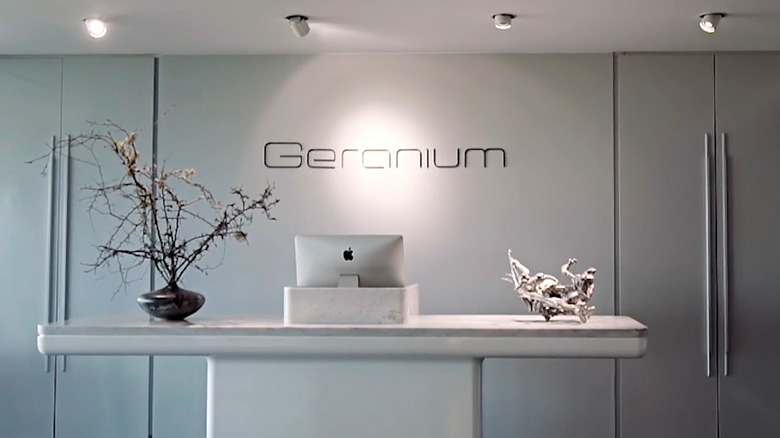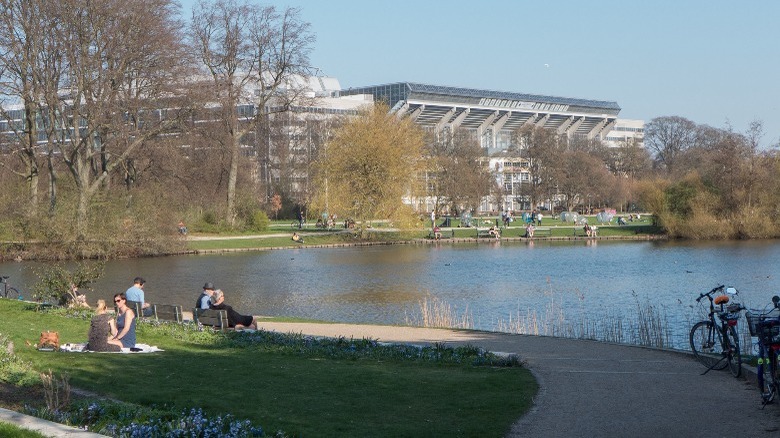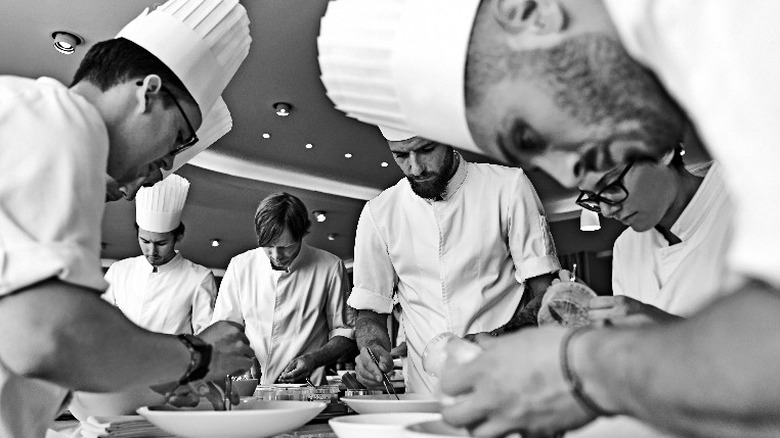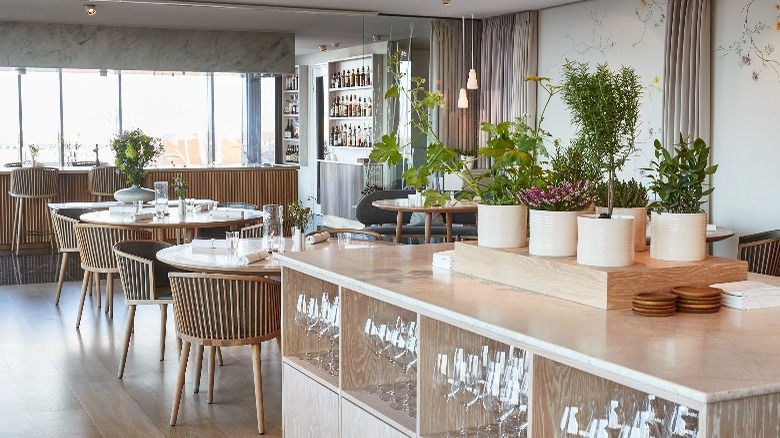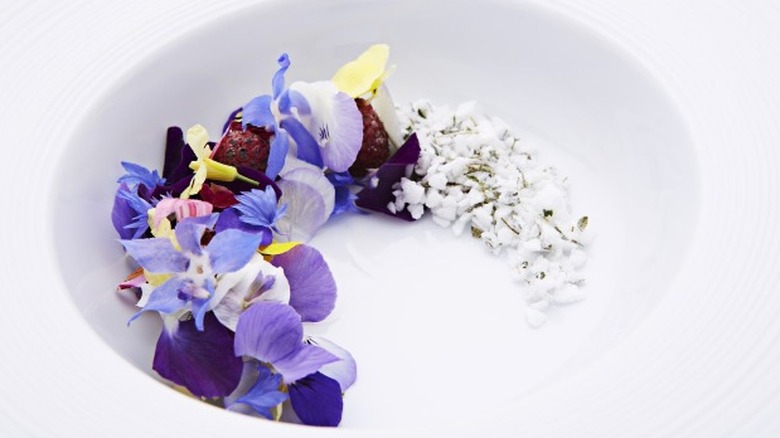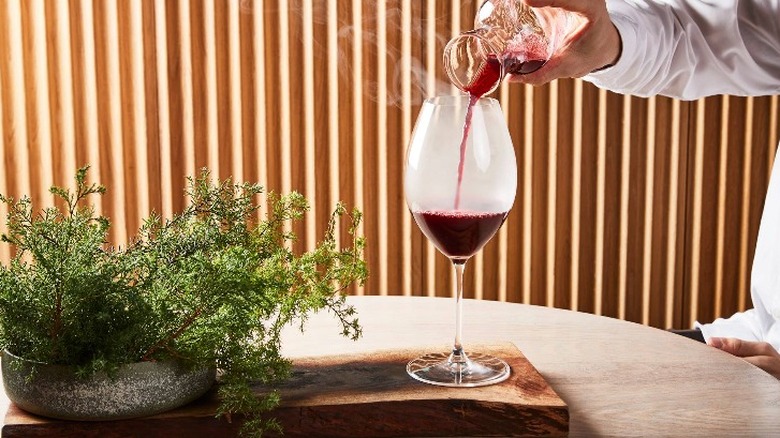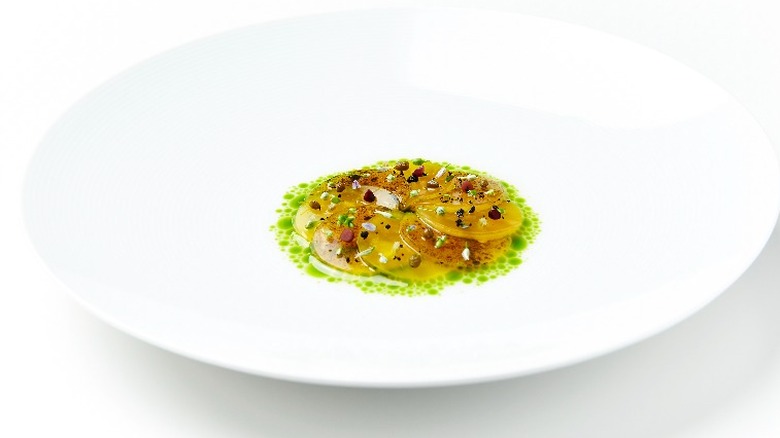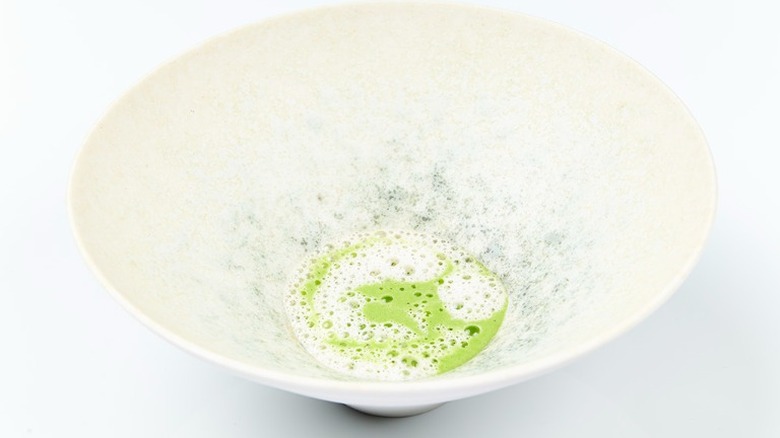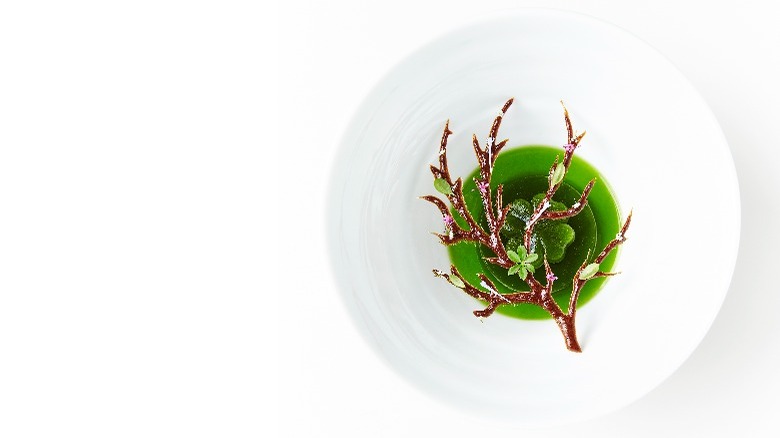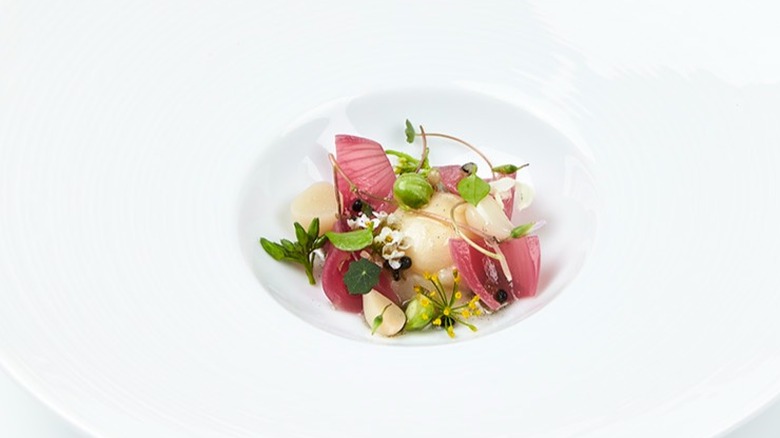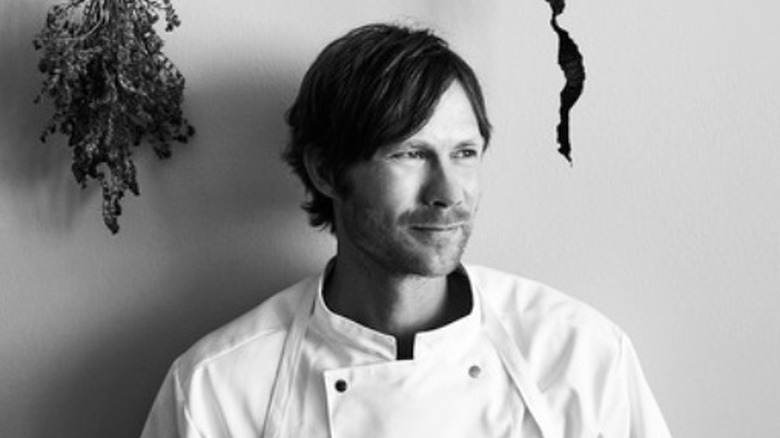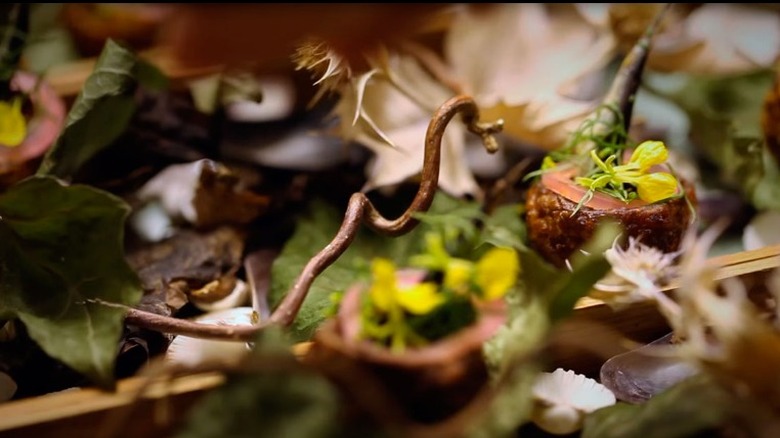Everything You Need To Know About Geranium, The World's Best Restaurant
In the world of ultra-fine dining, there are many different awards and nominations to distinguish the average from the truly excellent. Unlike some designations that offer accolades like stars, the World's 50 Best Restaurants list is a definitive ranking, where only one restaurant can take the top spot. Every year, over a thousand voters choose from noteworthy new and existing restaurants in their region. The voters must have dined at the restaurant in the last eighteen months, and all voting is completely anonymous and confidential.
This year, there were many amazing restaurants pushing the boundaries of both flavor and execution, but only one was named the best: Geranium. This Nordic restaurant based in Denmark beat competitors from around the globe after being reviewed by a panel of industry experts, made up of chefs, restaurateurs, food writers, and "well-traveled gourmets." The winning restaurant has to reach perfection on all levels, from the food to the beverages to the service. Here's everything you need to know about Geranium, the World's Best Restaurant in 2022.
It's located in a football stadium in Copenhagen
If you want to visit Geranium, you'll have to travel to Denmark — Copenhagen, to be exact. This renowned food city is home to many amazing restaurants, like Noma (which has won the best restaurant designation multiple times). In the heart of Copenhagen is Fælledparken, a large park that is home to Denmark's national football stadium. Like the restaurant itself, the stadium offers some of the best in Danish architecture, with clean, modern lines and thoughtful design.
This sleek, newly designed stadium houses Geranium in one of its exterior spaces, so you won't be watching football while you eat. Instead, diners can expect sweeping views of the park through the floor-to-ceiling glass windows that encircle the restaurant. The view provides the perfect backdrop for the ultra-seasonal menu. Imagine tasting rich autumnal Nordic flavors while seeing the gorgeous fall foliage color the park.
Geranium first opened in 2007, at a different location
Geranium originally opened in 2007 in the King's Gardens near Rosenborg Castle in Copenhagen. The idea for the restaurant was born when chef Rasmus Kofoed decided to go into business with Søren Ledet, his friend, and business partner. They agreed that Kofoed would run the kitchen, and Ledet would handle the wine and front-of-house management. After receiving their first Michelin star just one year later, Geranium soon became the buzz of the town.
In 2010, Geranium closed and moved to its current location in the National Football Stadium following the bankruptcy of one of the investors. With new funding secured, Kofoed and Ledet were able to renew their dream for the restaurant and found their current space. Just a few years later, Geranium earned its second Michelin star, followed by a third star the next year.
Reservations open three months in advance, and there's always a wait list
Thinking about booking a ticket to try this world-class restaurant? You might have to plan in advance. Geranium opens its reservations three months in advance, but reservations always book up within minutes. To snag a reservation, set your alarm and access their system in the morning (Copenhagen time) precisely three months before you'd like to dine. If you're timely and flexible with your schedule, you might just be able to snag a table. If not, the restaurant does offer a wait list they can put you on in case another group cancels.
It might be hard to book an international trip around an uncertain wait list. If you're worried, you can always try calling them directly during their open hours to speak to someone directly. As with all hard-to-get reservations, some luxury hotels and credit cards have a concierge service that may be able to get you in.
It's completely meat-free
The chef of Geranium, Rasmus Kofoed, considers his restaurant to be an extension of himself. As such, the concept has transformed along with the chef's own aversion to meat. Kofoed describes the menu as "a reflection of me, of who I am & how I am evolving as a chef & as a human being." After giving up meat in his diet for five years, the chef decided that the "most natural" progression for Geranium would be for the restaurant to follow suit as well.
Last year, in 2021, Geranium announced that it would no longer serve meat on its menu. Instead, the menu will highlight Nordic seafood and produce from local, organic, and biodynamic farms in the area. The change was widely regarded as a positive step for the restaurant and for the food world as a whole. As The New York Times has reported, many top-tier restaurants around the globe have been adopting the same strategy for reasons ranging from creativity and innovation to sending a message about how sustainability can lower food costs in a changing world.
The drinks are just as inventive as the food
For a restaurant of this caliber (and price point), you would hardly expect the dedication and commitment to excellence to stop with the food. In order to expertly pair with food, the beverage offerings are as equally inventive and seasonal. In years past, fine dining restaurants put most of the emphasis on wine, but that's been changing as of late.
Chef Rasmus Kofoed first opened Geranium with his business partner and friend, Søren Ledet. Ledet is an advanced sommelier, and heads the wine program as well as runs the restaurant as general manager. He is in charge of everything that comes in a glass at Geranium, whether that's wine, cocktails, or non-alcoholic libations. For the non-alcoholic crowd, there are juice blends like rhubarb with geranium and carrot or sea buckthorn and lovage. Cocktails could be anything from a crisp blend of dill snaps to fresh-pressed green apple juice and even chartreuse (a drink called The Last Word).
It's tasting menu only, and you'll be served around twenty courses
In the world of fine dining restaurants, there's been a recent trend to offer tasting menus of the chef's design. That means that instead of an à la carte menu (where you can read from a list of selections and choose one or two that you'd like), you'll be served a number of dishes, usually smaller in size, meant to represent the scope of the chef's creativity and expertise.
While some restaurants offer a choice between an à la carte menu and a tasting menu, Geranium is tasting menu only. If you are dining there, you can expect to be served a series of around twenty dishes, each made up of just a few bites. While the menu that lists the dishes is broken down into "appetizers," "savory servings," and "sweets," it does not reflect their size. Instead, this gives the diner a hint into the type of flavors they can expect to taste during this section.
The menu combines Danish flavors with local produce
Chef Rasmus Kofoed's creative vision for the menu at Geranium is to highlight the best of Danish and Nordic cuisine using local flavors, techniques, and ingredients. While the menu changes often, each dish perfectly complements the time of year, as well as an integral part of the region. Some dishes may pay homage to a classic dish or preparation, while others may be pushing the boundaries of science and innovation in the food world.
There are dishes that highlight seafood, like the Danish Tradition, a dish of salted herring in crispy algae with dill stems & aquavit. Some dishes focus on local produce, like the Winter Greens from Kiselgården, which features flowering Brussels sprouts, leeks & wild onions. Kiselgården is one of the oldest biodynamic farms in Denmark, and it provides vegetables to many of the top restaurants in Copenhagen.
A meal there costs about $322
A meal at a restaurant like Geranium is more than just dinner; it's an experience. You should expect your meal here to take a minimum of three hours, between all the courses you'll be eating and wine or beverage pairings to go with it. For this reason, most people who enjoy this type of dining prefer to see it as a show or performance, almost like going out to the theater. At a meal like this, you'll be taking in more than just bites of food; it's akin to a cultural symposium meant to provoke thought and conversation.
It's also why people fill the restaurant night after night, even though a meal here will set you back about 3200 DKK (or $322). It may seem like a hefty price to pay for dinner — and that doesn't include any drinks, either — but for some, the cost is well worth it.
A wine pairing can cost more than $1800
If you thought the cost of dinner at Geranium was high, you might be shocked by the wine pairings. Wine and beverage pairings are offered separately from any food and come at a few different price points. For example, the Heart & Soil pairing is only 2000 DKK, or $200. The pairing packages go up from there, with Classic & Appellation and Big & Bold ringing in 4000 DKK ($405) and 6000 DKK ($607), respectively.
For those looking for that truly next-level wine experience, Geranium offers the Rare & Unique package for a cool 18,000 DKK, which comes out to about $1800. A true wine aficionado may find this to be a paltry sum in order to go on a taste experience that can match the unbelievable flavors of the food. For those with an aversion to alcohol, there's also a non-alcoholic pairing for just 1300 DKK ($130).
It debuted on the World's 50 Best list at 49th in 2012
Geranium achieved the award for the Best Restaurant in the World in 2022, but its road toward this honor has been paved all the way with awards and accolades. It was first recognized by this list back in 2012, where it debuted in the 49th spot. Over the years, it steadily climbed in the rankings until it reached second place in 2021. Finally, this year, the restaurant took the top spot. All this came after the World's 50 decided to do a complete overhaul following the 2020 pandemic. After all the uncertainty over the last few years, no one could have predicted how the restaurant world would look going forward.
The award, announced this year by Stanley Tucci, came as a surprise even to Kofoed himself. To him, the "magical moment still feels like a dream," especially after so many years of hard work and dedication to make Geranium what it is today.
Chef Rasmus Kofoed is an avid runner
When he's not dreaming up new and delicious flavors or running the pass at Geranium, chef Rasmus Kofoed spends much of his free time running and competing in 5k marathons. He's in tip-top shape and can pull off a 10k in under forty minutes. No matter where his cooking takes him around the world, Kofoed finds time to get a run it, whether it's the banks of the Rhone or the gardens of Versailles.
It's more than just a way for him to stay in shape, though. "Running clears my mind but also stimulates my creative spirit," states Kofoed via his Instagram. He's constantly pushing himself to achieve better and better times. Could this be the secret to his success? Certainly, staying in peak physical shape must help support long, grueling days at the restaurant. A spirit of constant improvement and drive is central to Kofoed's life and business ethos.
Chef Kofoed has won bronze, silver, and gold in the Bocuse d'Or
One of the most famous and prestigious culinary competitions in the world is called the Bocuse d'Or. Founded by famed chef Paul Bocuse in 1987, this incredibly challenging competition is held every two years in Lyon, France. Twenty-four countries from around the world compete and are only allowed to enter one chef (along with one assistant).
Impressively, chef Rasmus Kofoed has won the bronze, silver, and gold medals at Bocuse d'Or. He took home the silver medal the same year the original Geranium was opened in 2007 and the gold a few years later in 2011. Placing in this unique competition would already be impressive enough. However, the fact that Kofoed has won all three medals during different competitions is a feat never before (or since) achieved by another chef. These days, Kofoed still attends the event to spectate and judge future winners.
One of the signature dishes is a razor clam tartare in an edible shell
Chef Rasmus Kofoed's menu at Geranium is known for presenting familiar ingredients in surprising ways. One of the signature dishes at the restaurant is called Razor Clam: A Childhood Memory. Per the dining blog Scallion Pancake, the "shell" of the clam isn't actually a shell at all. Instead, it's a sort of edible cracker made from wheat flour and painted with algae and charcoal to look like the shell of a razor clam. Inside is a tartare made with razor clam and sour cream.
It's these sorts of surprising twists that make dining at Geranium such a fun and interesting experience. Dishes like the Razor Clam are edible works of art designed to play on perspective and expectation. What you see before you on the plate may lead you to make an assumption, but one bite and you are transported to a completely different place. Inside, all that mystery and intrigue is a dish that recalls a very specific memory of chef Kofoed's childhood, which he shares with his guests using food.
They had a scandal in 2016 for not storing shellfish properly
Even the best restaurants in the world aren't without scandal. In 2016 (the same year Geranium became the first restaurant in Denmark to earn three Michelin stars), the restaurant faced a fine for improperly storing food in the kitchen (via CPH Post Online). The offending ingredient, in this case, was shellfish, which must be stored below 32 degrees F. Health inspectors in Copenhagen found that on multiple occasions, Geranium was found to be storing their shellfish several degrees higher than this.
In addition to the improperly stored shellfish, several walk-in coolers had splotches growing on the underside of shelving that was also found on a package of pickled garlic (per Ekstra Bladet). Some other areas of the kitchen were also found to have been lacking in terms of hygiene and cleanliness. In all, the chef was find 20,000 DKK and issued the lowest possible health designation for a restaurant in Copenhagen.
It was Denmark's first restaurant to earn three Michelin stars
In the food world, there are few honors higher than the coveted Michelin stars. To earn three means complete excellence in every way. After just three short years of being open, Geranium received one star from the Michelin guide, and by 2013, they had earned three stars. Even though other Danish restaurants have since received three stars, Geranium was the first restaurant in Copenhagen to do so (via Wonderful Copenhagen).
In total, Copenhagen boasts an impressive twenty stars across sixteen different restaurants in the city. Foodies and chefs from around the globe travel to Denmark to be inspired by the Nordic cuisine being served at these incredible restaurants. Establishments like Geranium have put Nordic and Scandinavian food on the map culinarily, cementing this cuisine as one of the most fascinating and unique in the world. Thanks to chefs like Rasmus Kofoed, who are constantly pushing the boundaries of technique and skill, the culture of the food world is more innovative than ever before.
